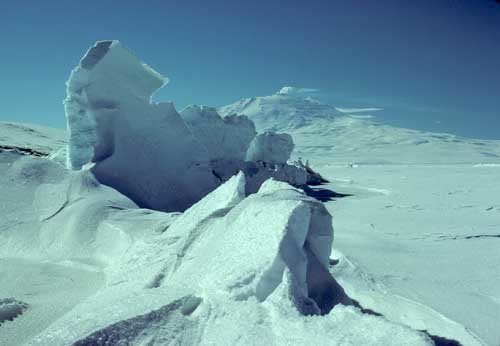The most familiar portion of the Transantarctic Mountains is southern Victoria Land, where Robert Falcon Scott and Ernest Shackleton built their bases on Ross Island, and where New Zealand's Scott Base and the U. S. McMurdo Station are located today. Standing 45 miles out from the mountain front across McMurdo Sound, Ross Island boasts the world's southern most active volcano, Mt. Erebus, with a continuously convecting lava lake at its summit. Ross Island is also strategically located at the margin of the Ross Ice Shelf, giving access to the interior of the continent, while allowing ships to resupply during the summer break-out of seasonal ice.
In the previous post on northern Victoria Land, we toured south as far as the polynya at the southern end of Terra Nova Bay. Immediately to the south, the bay terminates at the Drygalski Ice Tongue, a gigantic, floating glacier, formed where the East Antarctic Ice Sheet pours through a low stretch of the mountains. Encircled by sheer, 150-foot cliffs of ice, the ice tongue measures 15 miles in width and more than 30 miles in length from where it leaves the mountain front and enters the Ross Sea.
For 100 miles south of the Drygalski Ice Tongue, the Transantarctic Mountains stand in low relief behind an apron of fast ice. Beyond that one comes to Granite Harbour, a reentrant in the mountain front, so-named by Scott when he sailed into the bay in 1902, landed with a ground party and climbed to the top of Discovery Bluff. There the men surveyed the splendid natural harbor, split by a modest ice tongue, and collected granite, the bedrock of the area.
The region to the south of Granite Harbour encompasses the McMurdo Dry Valleys, a trio of drainages crossing the mountains, where once-upon-a-time outlet glaciers flowed from the polar plateau. Each of the valleys has a lake approximately midway along its length, which during the austral summer is fed by streams generated from melting ice at both ends of the valleys. Being within easy helicopter distance of McMurdo Station and having such a unique landscape and ecosystem, the Dry Valleys have hosted more scientific research than any other sector of the Transantarctic Mountains.
The northernmost of the Dry Valleys is Victoria Valley, explored for the first time during the International Geophysical Year (IGY), 1957-58. Three broad tributary valleys merge into lower Victoria Valley, where the aquamarine ice of Lake Vida centers a spacious landscape of variegated brown. Helicopters flew scientists into Wright Valley, the next dry valley to the south, for the first time the following year.
Wright Valley is more confined than Victoria Valley, with 5,000 foot walls gracefully curving upwards from the valley floor. In its lower section, a set of spectacular hanging glaciers reaches down from the snow accumulation zone at the top of the Asgaard Range. Meltwater from these glaciers feeds the Onyx River, flowing seasonally into Lake Vanda at the bottom of the valley. At the upper end of Wright Valley, the last remnants of the glacier that once fed the valley below have retreaded, exposing an extra-terrestrial landscape of interlocking, 300-foot canyons, known as The Labyrinth.
Taylor Valley, the third of the McMurdo Dry Valleys, was discovered in 1903 by a party led by Scott. Unlike its sisters to the north, this valley still has a glacier in the upper reaches of its drainage, which peters out in a steep termination at the upper end of Lake Bonney. The bedrock exposed in the mountains around the upper end of Taylor Glacier displays a dramatic interleaving of white sandstone layers intruded by black basalt.
Immediately south of Taylor Valley is Ferrar Glacier, the first outlet glacier south of Granite Harbour. In 1902, a party led by Albert Armitage, second in command on Scott's first expedition, ascended Ferrar Glacier, becoming the first to cross the Transantarctic Mountains and reach the polar plateau. The Royal Society Range rises to the south of Ferrar Glacier to heights in excess of 12,000 feet. This blocky rampart stands majestically at the southern end of McMurdo Sound, and is a grand sight from McMurdo Station or Scott Base. Beyond that Mt. Discovery, a dormant, volcanic sister to Mt. Erebus, stands sentry at the gateway to the central Transantarctic Mountains and the great beyond.
